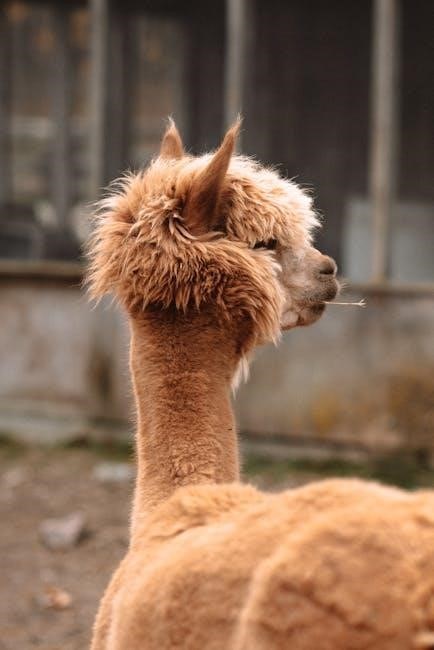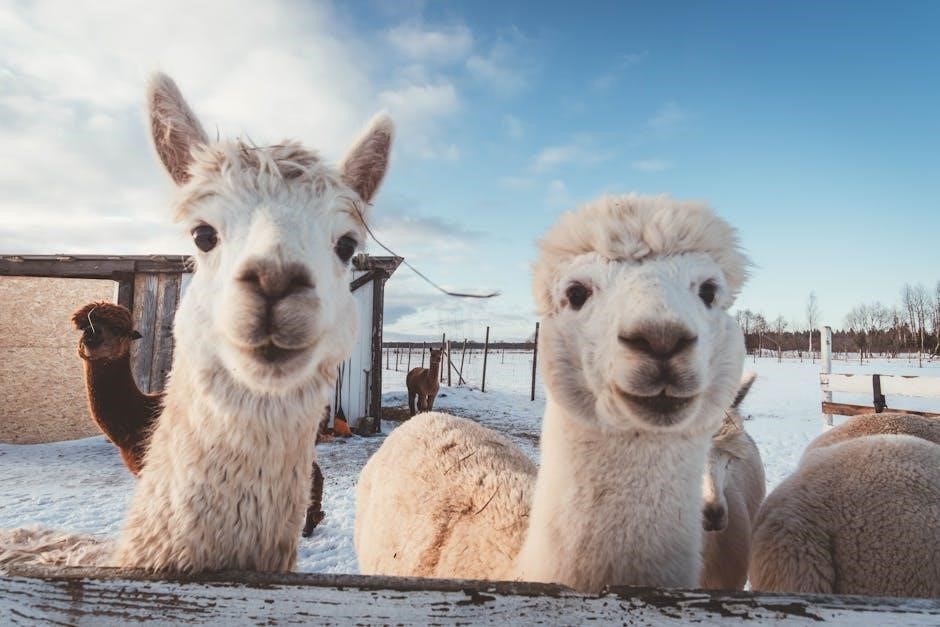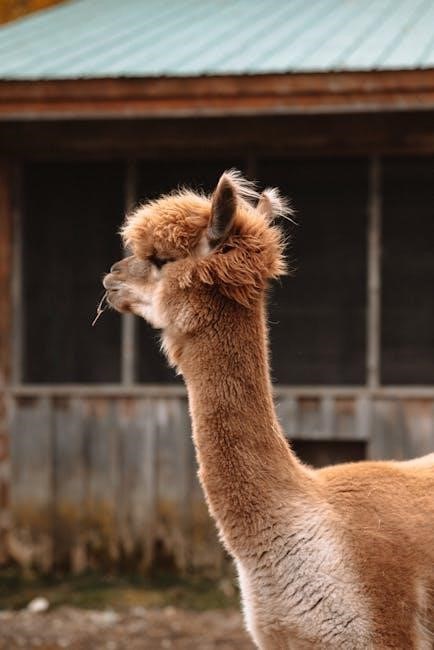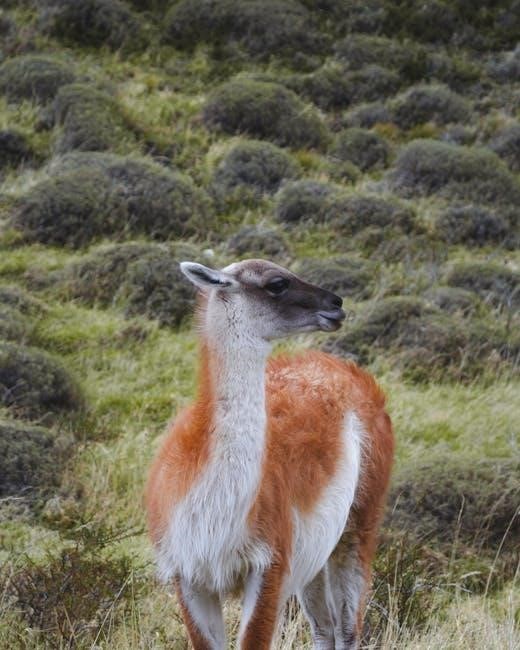washing instructions for alpaca wool
Alpaca wool is a soft, luxurious fiber from alpacas, known for its lightweight, warm, and hypoallergenic properties. Originating in South America, it is prized for its durability and eco-friendly nature. Unlike other wools, alpaca fibers lack lanolin, making them easier to clean but still requiring gentle care to preserve their softness and texture.
1.1. What is Alpaca Wool?
Alpaca wool is a natural, soft, and lightweight fiber obtained from alpacas, primarily bred in South America. It is hypoallergenic, lacking lanolin, making it easier to clean than other wools. Alpaca wool is durable, warm, and comes in two main types: Huacaya (soft and crimped) and Suri (long and silky). Its unique properties, such as moisture-wicking and thermal insulation, make it highly valued for textiles. Understanding its fiber characteristics is essential for proper care and washing to maintain its softness and longevity.
1.2. Why Special Care is Needed
Alpaca wool requires special care due to its delicate fiber structure. Unlike other wools, it lacks lanolin, making it prone to shrinkage and pilling if not handled gently. Exposure to hot water or harsh detergents can damage the fibers, leading to loss of softness and shape. Proper washing techniques are essential to preserve its texture, warmth, and longevity. Using mild detergents and avoiding machine washing helps maintain the natural integrity of alpaca wool, ensuring it remains soft and durable for years.

Understanding Alpaca Fiber
Alpaca fiber is lightweight, warm, and hypoallergenic, making it ideal for sensitive skin. It lacks lanolin, reducing the need for harsh cleaning products and making it easier to care for compared to other wools.
2.1. Types of Alpaca Wool
Alpaca wool is available in two main types: Huacaya and Suri. Huacaya fibers are soft, crimped, and voluminous, while Suri fibers are long, silky, and lustrous. Both types are lightweight and warm, but their textures differ. Huacaya is more common and has a fluffy appearance, making it ideal for garments requiring structure. Suri, with its smooth texture, is often used in scarves and fabrics where drape is important. Each type requires similar care but may benefit from specific washing techniques to maintain their unique qualities. Understanding these differences helps in choosing the best washing method for your alpaca items.
2.2. Properties of Alpaca Fibers
Alpaca fibers are soft, lightweight, and warm, making them ideal for garments. They are hypoallergenic, lacking lanolin, which simplifies washing. The fibers are durable, with excellent stitch definition and resistance to pilling. Alpaca wool is naturally water-resistant and breathable, providing warmth in cold weather and cooling in heat. Its eco-friendly nature and sustainable sourcing add to its appeal. These properties make alpaca wool a versatile and desirable material for crafting high-quality, long-lasting textiles.

Preparation for Washing
Inspect alpaca items for stains or snagging. Turn garments inside out to protect fibers. Use a mesh laundry bag for machine washing to prevent damage.
3.1. Checking Labels for Instructions
Always begin by examining the care label on your alpaca wool item. Look for specific washing instructions, symbols, or recommendations. Many alpaca garments require hand washing, while others may permit machine washing on a gentle cycle. Check for temperature guidelines, as hot water can cause shrinkage. Some labels may suggest dry cleaning, though hand washing is often preferred to preserve softness. Follow these instructions carefully to ensure longevity and maintain the fabric’s quality.
3.2. Sorting and Grouping Alpaca Items
Before washing, sort alpaca wool items by color and fabric type to prevent dye bleeding or snagging. Separate delicate or lightweight garments from heavier ones to avoid damage. Grouping similar items ensures even washing and prevents friction. Consider placing delicate alpaca items in mesh laundry bags for added protection. This step helps maintain the quality and softness of the wool, ensuring a gentle and effective cleaning process.
Hand Washing Instructions
Fill a sink with cold water, add a mild detergent, and gently submerge the alpaca garment. Avoid agitation, then rinse thoroughly and reshape before air drying.
4.1. Materials Needed
To hand wash alpaca wool, gather mild detergent, cold water, a clean sink, and a towel. Use a gentle wool detergent or baby shampoo to preserve softness. Avoid harsh chemicals or fabric softeners that can damage fibers. A basin or sink with lukewarm water is ideal for soaking. Gently agitate the water to distribute the detergent evenly. Ensure the water is not too hot, as heat can cause shrinkage or felt the fibers. A soft-bristle brush can help remove dirt, but avoid scrubbing too hard. After washing, reshape the garment and lay it flat to air dry, away from direct sunlight.
4.2. Filling the Sink with Water
Fill a clean sink with cold or lukewarm water, ideally between 30°C and 35°C. Avoid hot water, as it can cause shrinkage or felting. Ensure the sink is free of contaminants before adding water. Once filled, gently add a small amount of mild detergent, stirring lightly to distribute it evenly. Submerge the alpaca garment, making sure it is fully covered by water. Avoid agitating the water excessively at this stage to prevent fiber damage.
4.3. Adding Mild Detergent
Add a small amount of mild detergent specifically designed for wool or delicate fabrics. Avoid harsh detergents, as they can damage alpaca fibers. Gently dissolve the detergent in the water before submerging the garment. Use approximately one teaspoon of detergent for a standard-sized sink. Avoid over-sudsing, as residue can affect the softness of the wool. Ensure the detergent is evenly distributed to prevent uneven cleaning. Do not agitate the water excessively after adding the detergent.
4.4. Submerging the Garment
Gently place the alpaca wool garment into the water, ensuring it is fully submerged. Avoid agitating or wringing the fabric, as this can cause felting or damage. Use your hands to lightly press the garment underwater, making sure all parts are covered. Allow it to soak for 15–20 minutes to let the detergent work effectively. Do not leave it submerged for too long, as this may lead to excessive water absorption. Check the care label for specific submersion recommendations.
4.5. Gently Agitating the Water
Once submerged, gently agitate the water with your hands in a soft, sweeping motion. Avoid scrubbing or wringing the fabric, as this can damage the delicate fibers. Use a mild detergent specifically designed for wool, and ensure it is fully dissolved before submerging the garment. Agitate only enough to distribute the detergent evenly, then allow the garment to soak without further disturbance. Over-agitation can cause felting or shrinkage. Always check the care label for specific agitation instructions.
4.6. Rinsing Thoroughly
Rinse the alpaca wool garment under cold, running water to remove all soap residue. Gently swish the fabric in clean water, ensuring no detergent remains. Repeat if necessary. Avoid wringing or twisting, as this can stretch or felt the fibers. Once rinsed, carefully press out excess water without wringing. Residue left behind can cause stiffness or discoloration over time. Proper rinsing ensures the wool retains its softness and natural texture, maintaining its quality and longevity.

Machine Washing Instructions
Place the alpaca wool garment in a mesh laundry bag. Select a gentle or delicate cycle on your washing machine. Use cold water and a mild detergent. Avoid harsh chemicals or fabric softeners. Gently wash without excessive agitation. Once done, carefully remove and press out excess water without wringing.
5.1. Using a Gentle Cycle
For machine washing alpaca wool, always use a gentle or delicate cycle. This ensures minimal agitation, preventing damage to the fibers. Place the garment in a mesh laundry bag for added protection. Select cold water to avoid shrinkage and color fading. Use a mild, wool-safe detergent without harsh chemicals or fabric softeners. Avoid using high-speed spin cycles, as they can cause pilling or distortion. Gently remove the garment from the machine and reshape it before drying.
5.2; Selecting the Right Water Temperature
Always use cold water when washing alpaca wool to prevent shrinkage and fiber damage. The ideal temperature is between 30°C (86°F) and 40°C (104°F), but cold water is the safest option. Hot water can cause the fibers to felt and lose their softness. Avoid sudden temperature changes, as they can harm the material. For best results, use water that feels cool to the touch. This gentle approach ensures the wool remains soft and retains its natural texture.
5.3. Placing the Garment in a Mesh Bag
Before machine washing, place your alpaca wool garment in a mesh laundry bag to protect it from friction and snagging. This step prevents pilling and damage during the wash cycle. Gently slide the garment into the bag, ensuring it is not overcrowded, as this could cause stretching or distortion. Using a mesh bag adds an extra layer of protection, making machine washing safer and more gentle for your delicate alpaca wool items.

Drying Alpaca Wool
Drying alpaca wool requires careful attention to preserve its softness and texture. Air drying is essential, as direct heat can damage the fibers. Lay the garment flat in a cool, well-ventilated area, away from direct sunlight, to maintain its natural shape and quality.
6.1. Reshaping the Garment
After washing, gently reshape the alpaca garment while it is damp to restore its original form. Lay it flat on a clean, dry towel, smoothing out wrinkles and ensuring even drying. Avoid stretching or pulling the fabric excessively, as this can misshape the garment. Reshaping helps maintain the item’s natural texture and fit, preventing it from losing its structure during the drying process. This step is crucial for preserving the quality and appearance of alpaca wool.
6.2. Laying Flat to Air Dry
After reshaping, lay the alpaca garment flat on a clean, dry towel in a well-ventilated area. Ensure it is away from direct sunlight, as UV rays can cause fading or shrinkage. Avoid hanging the garment, as it may stretch. Allow it to air dry naturally, which helps preserve the fibers’ softness and texture. This method prevents moisture buildup and ensures even drying, maintaining the wool’s natural properties and extending its lifespan.
6.3. Avoiding Direct Sunlight
Direct sunlight can cause alpaca wool to fade and weaken, so it’s essential to keep it out of direct UV rays. Instead, place the garment in a shaded or indirectly lit area to dry. This prevents color fading and maintains the wool’s natural texture. Avoid placing it near heaters or radiators, as heat can shrink or damage the fibers. Proper drying in a cool, shaded space ensures the alpaca wool retains its softness and durability over time.

Storage Tips
Store alpaca wool in breathable containers, away from moisture and direct sunlight. Fold items instead of hanging to prevent stretching and maintain shape. Keep in a cool, dry place to preserve quality and softness.
7.1. Using Breathable Containers
Store alpaca wool in breathable containers like cotton bags or mesh-lined boxes to maintain airflow and prevent moisture buildup. Avoid plastic bags, as they trap humidity and can lead to mildew. Use acid-free tissue paper to line the container for extra protection. Ensure the container is clean and dry before placing the garment inside. This method helps preserve the natural fibers and keeps the wool soft and fresh for longer.
7.2. Keeping Away from Moisture
Alpaca wool should be stored in a cool, dry environment to prevent moisture damage. Avoid basements or attics with high humidity. Use silica gel packets or breathable containers to absorb excess moisture. Regularly check stored items for dampness. Never store alpaca wool in plastic bags, as they trap moisture and can lead to mildew. Ensure the storage area is well-ventilated to maintain dry conditions and preserve the wool’s natural texture and softness over time.

Common Mistakes to Avoid
Using hot water and harsh detergents can damage alpaca wool. Avoid over-agitating the fibers, as this can cause pilling or shrinkage. Always use mild detergents and gentle cycles.
8.1. Using Hot Water
Using hot water when washing alpaca wool is highly detrimental, as it can cause the fibers to shrink, felt, or weaken. Hot water damages the natural texture of alpaca wool, leading to a rough, misshapen fabric. Always opt for cold or lukewarm water to preserve the softness and integrity of the fibers. Avoiding hot water ensures the garment retains its size, color, and luxurious feel for years to come.
- Hot water causes irreversible shrinkage.
- It can felt the fibers, ruining the fabric.
- It weakens the fabric over time.
8.2. Agitating the Fibers Too Much
Agitating alpaca fibers excessively can cause irreversible damage, such as felting or pilling. Gentle care is essential to preserve the softness and texture. Avoid vigorous scrubbing or rubbing, as this can weaken the fibers and lead to a rough, distorted fabric. Instead, use a soft, gentle motion to clean the garment. Over-agitation disrupts the natural alignment of the fibers, ruining the fabric’s appearance and feel. Always handle alpaca wool with care to maintain its quality and longevity.
- Agitation causes felting and pilling.
- It weakens the fibers and distorts the fabric.
- Gentle care preserves softness and texture.
Maintaining the Softness
To preserve the softness of alpaca wool, use gentle detergents and avoid harsh chemicals. Reshape garments while damp to maintain their natural texture and drape.
- Use mild detergents specifically designed for wool.
- Avoid excessive agitation, which can roughen fibers.
9.1. Using Fabric Softeners
Fabric softeners can leave residues on alpaca wool, reducing its natural softness and breathability. Instead, opt for mild detergents or vinegar rinses to maintain softness without harmful buildup.
- Avoid traditional fabric softeners, as they can damage fibers.
- For extra softness, add a 1/2 cup of white vinegar during the rinse cycle.
- Natural alternatives like vinegar help balance pH and preserve texture.
9.2. Avoiding Harsh Detergents
Harsh detergents can strip alpaca wool of its natural oils, leading to dryness and potential damage. Enzyme-based or biological detergents should be avoided, as they can break down the fibers. Instead, use mild, pH-neutral detergents specifically designed for wool or delicate fabrics. These gentle cleansers preserve the softness and integrity of alpaca wool without causing shrinkage or felting;
- Opt for wool-safe detergents to protect fibers.
- Avoid bleach, enzymes, or abrasive chemicals.
- Mild shampoos or baby detergents are suitable alternatives.

Professional Cleaning Options
For delicate or heavily soiled alpaca items, professional cleaning is recommended. Dry cleaning or specialized hand washing services ensure gentle care, preserving the wool’s softness and texture.
10.1. When to Choose Dry Cleaning
Dry cleaning is ideal for alpaca wool items with stubborn stains or intricate designs that hand washing might damage. It prevents shrinkage and maintains the garment’s shape and texture. Professional cleaners use solvents that gently remove dirt without agitating the fibers. This method is recommended for high-value or sensitive alpaca pieces, ensuring they remain pristine and retain their luxurious feel.

Recommended Products
For washing alpaca wool, use mild detergents like Woolite or Eucalan. These gentle cleansers preserve the fibers’ softness and prevent shrinkage. Consider natural alternatives like baby shampoo.
11.1. Mild Detergents for Wool
When washing alpaca wool, use mild, pH-neutral detergents specifically designed for wool, such as Woolite or Eucalan. These detergents gently clean without stripping natural oils. Avoid harsh chemicals or bleach, as they can damage fibers. For hand washing, baby shampoo or conditioner can also work well. Always opt for fragrance-free options to prevent irritation. These products ensure the wool remains soft, intact, and retains its natural texture. Proper detergent choice is key to maintaining alpaca wool’s quality and longevity.

Troubleshooting
Common issues include shrinkage and odor retention. Gently reshape shrunken items while damp and air dry. For odors, soak in cold water with vinegar before rinsing.
12.1. Fixing Shrinkage
To fix shrunken alpaca wool, start by soaking the garment in cold water with a mild detergent or conditioner for about 30 minutes. Gently reshape the item while it’s damp, laying it flat to air dry. Avoid stretching or pulling forcefully, as this can damage fibers. If the shrinkage is severe, professional cleaning or blocking may be needed. Always handle with care to restore its natural shape and softness without further damage.
12.2. Removing Odors
To remove odors from alpaca wool, soak the garment in cold water with a mild detergent or conditioner for 30 minutes. For persistent smells, add a small amount of white vinegar to the rinse water to neutralize odors. Avoid agitation and hot water, as they can damage fibers. Lay the garment flat to air dry, ensuring it dries completely to prevent mustiness. For stronger odors, repeat the process or use a fabric refresher spray; Always avoid harsh chemicals to maintain the wool’s softness and integrity.
Properly washing alpaca wool ensures its softness and longevity. Use cold water, mild detergents, and gentle agitation. Air dry and store in a cool, dry place to maintain quality.
13.1. Final Tips for Longevity
To ensure your alpaca wool items last, always use cold water, mild detergents, and gentle agitation. Avoid direct sunlight and moisture when storing. Reshape garments before drying and store them in breathable containers. Regularly cleaning and properly maintaining your alpaca wool products will preserve their softness and texture for years. By following these care tips, you can enjoy the warmth and beauty of alpaca wool while maintaining its quality and durability over time.
FAQ
- Can alpaca wool be machine washed? Yes, but only on a gentle cycle with cold water and a mild detergent.
- How often should I wash alpaca items? Wash sparingly to preserve fibers; spot cleaning is often sufficient.
14.1. Can Alpaca Wool Be Machine Washed?
Yes, alpaca wool can be machine washed, but it requires careful attention. Use a gentle cycle with cold water and a mild detergent specifically designed for wool. Place the garment in a mesh laundry bag to protect it from friction and snagging. Avoid using harsh detergents, bleach, or fabric softeners, as they can damage the fibers. If unsure, hand washing is always a safer option for delicate alpaca items.
14.2. How Often Should I Wash Alpaca Items?
Alpaca wool is lightweight and resistant to odors, reducing the need for frequent washing. Wash alpaca items only when necessary, as over-washing can damage the fibers. For minor spills, spot clean with a damp cloth. If washing, use cold water and a gentle detergent. Avoid harsh chemicals and machine drying. Air dry flat to preserve the texture. Wash alpaca garments every 3-5 wearings or seasonally if not worn regularly to maintain their softness and longevity.
